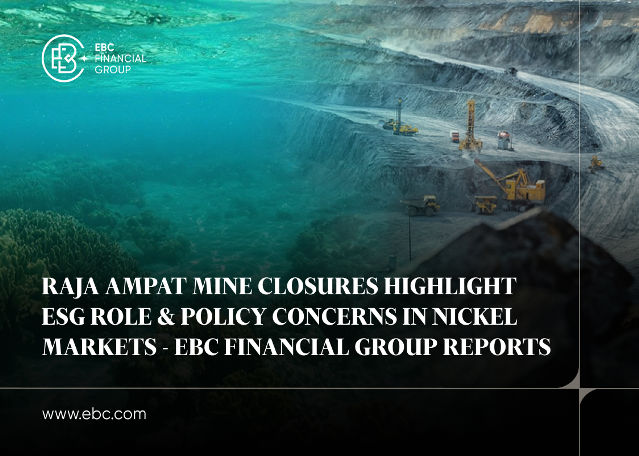ESG or Instability? What EBC Sees in the Raja Ampat Shutdown

Indonesia’s latest crackdown on nickel mining in the Raja Ampat region has triggered both applause from environmental groups and rising concern among traders. At EBC, we believe this event underlines how ESG decisions—however well-intentioned—can introduce significant policy and price risks across global commodity markets.
Raja Ampat Shuts Down – What It Means
The Indonesian government recently revoked permits for four nickel mining firms operating in the Raja Ampat islands, a UNESCO-protected marine region. While the move has been widely praised for its environmental leadership, one major nickel project near the border of the protected area continues operating. Legal disputes are now unfolding as affected companies attempt to reinstate their rights.
Indonesia produces 51% of the world’s nickel supply, so even actions outside key production zones can affect long-term market sentiment.
“The Raja Ampat case highlights the growing intersection of ESG factors, local community interests, and global market dynamics,” said David Barrett, CEO of EBC Financial Group (UK) Ltd. “For traders and investors, this is a wake-up call that commodity markets, especially in critical sectors like nickel, can be highly sensitive to environmental policy pressures.”
What Traders Should Be Watching
Nickel’s recent rebound could be misleading. Short-term price gains are often driven by supply fears, but the broader backdrop is one of volatility and uncertainty. Indonesia’s decision, while environmentally motivated, may lead to future restrictions that compound global supply risks.
“Traders need to stay alert not only to commodity volatility, but also to potential impacts on the rupiah, equities, and the country’s broader ESG risk profile,” Barrett added.
Nickel accounted for around 6.8% of Indonesia’s total exports in 2024. Any further disruption could shrink export revenues, put pressure on the rupiah (USD/IDR), and widen the country’s current account deficit.
Market Prices Show the Sensitivity
According to the Investing News Network, nickel prices fell to five-year lows in Q1 2025, briefly dipping below US 15,000 per metric ton due to oversupply and US tariff tensions. Prices have since recovered to around US 16,700 per ton, lifted by expectations of tighter supply. However, continued shutdowns or prolonged legal battles in Indonesia could trigger another wave of price shocks.
Beyond Mining – The Global Ripple Effect
In 2024, Indonesia produced an estimated 2.2 million metric tons of refined nickel—more than half the global total. While battery production is the long-term growth story, over two-thirds of today’s nickel still supports stainless steel manufacturing.
Approximately 75% of stainless steel grades depend on nickel to stabilise their structure. Any reduction in supply could hit multiple industries: automotive, construction, energy, aerospace, and even medical equipment. The result? Rising input costs and broader inflationary pressure across industrial supply chains.
A Shift Traders Cannot Ignore
While Raja Ampat’s mines may not have been major producers, their closure signals a regulatory pivot with global implications. For traders, that means staying alert to both environmental signals and legal developments—not just traditional output data.
Disclaimer: This material is for general information purposes only and is not intended as (and should not be considered to be) financial, investment or other advice on which reliance should be placed. No opinion given in the material constitutes a recommendation by EBC or the author that any particular investment, security, transaction or investment strategy is suitable for any specific person.





















